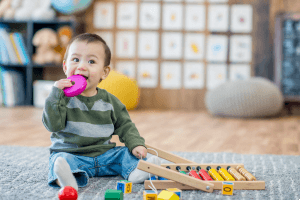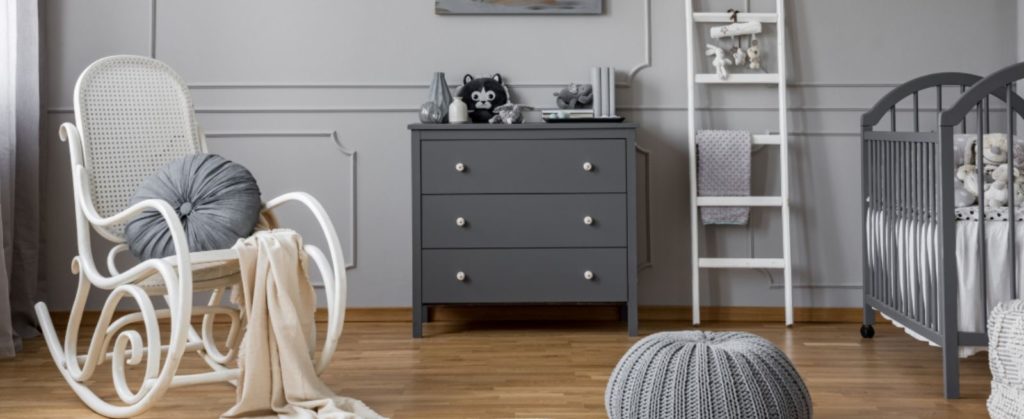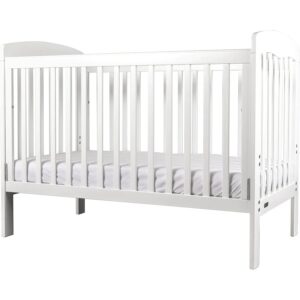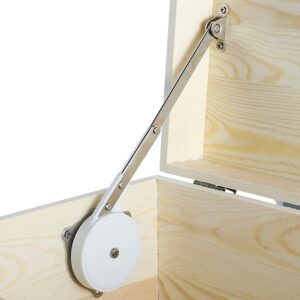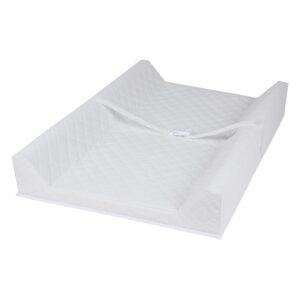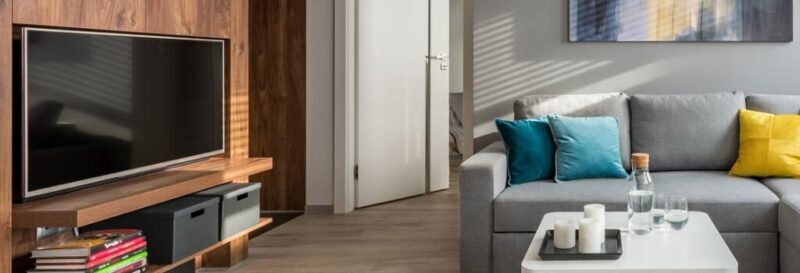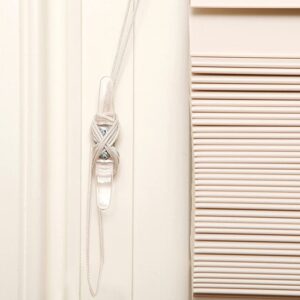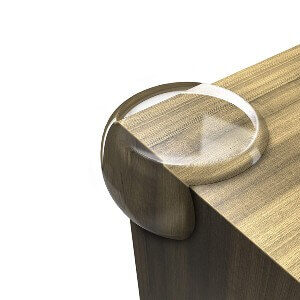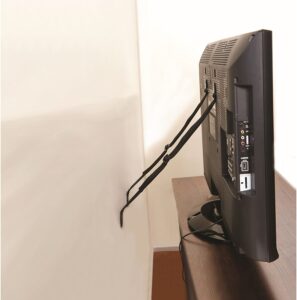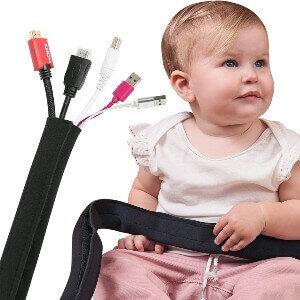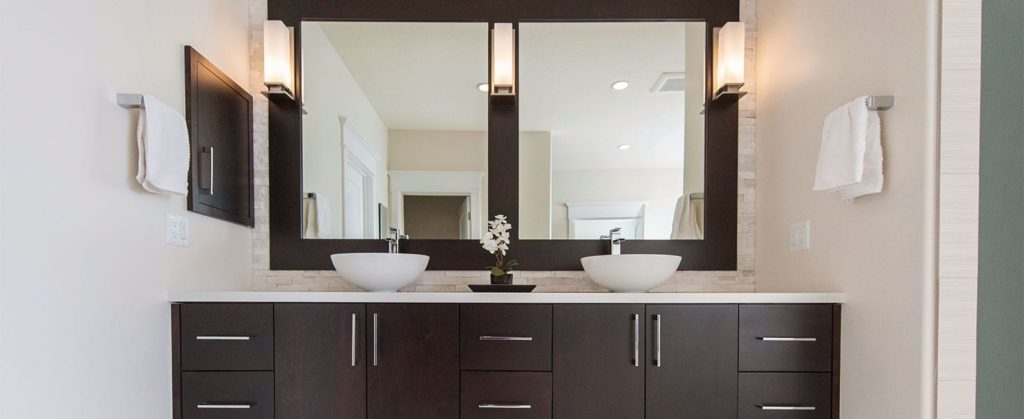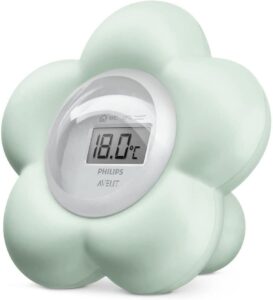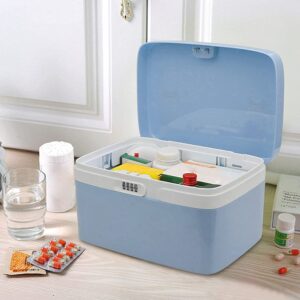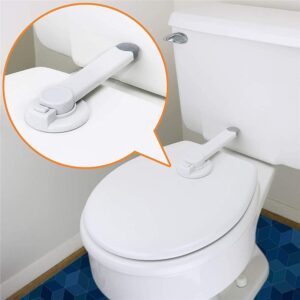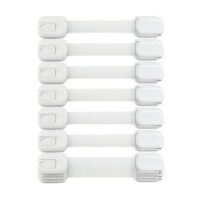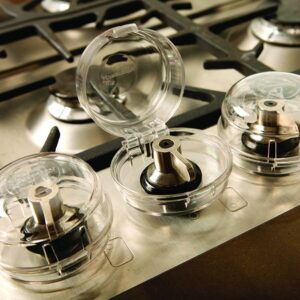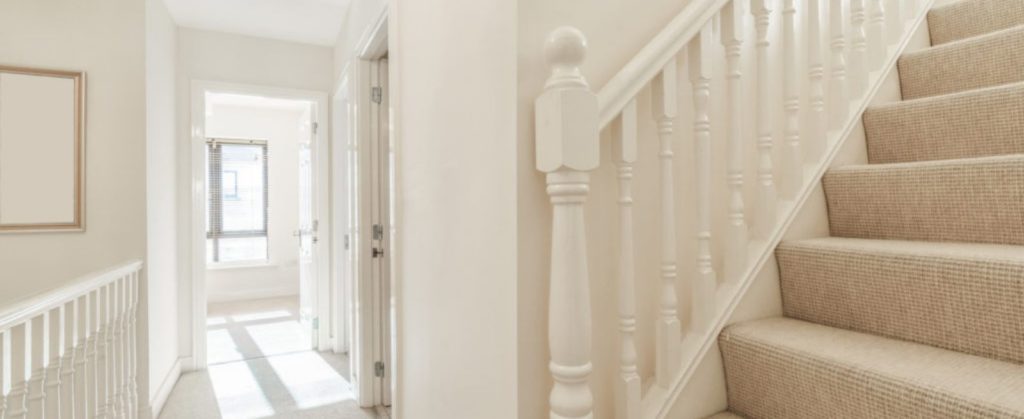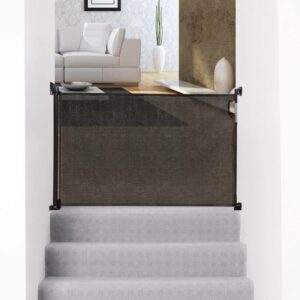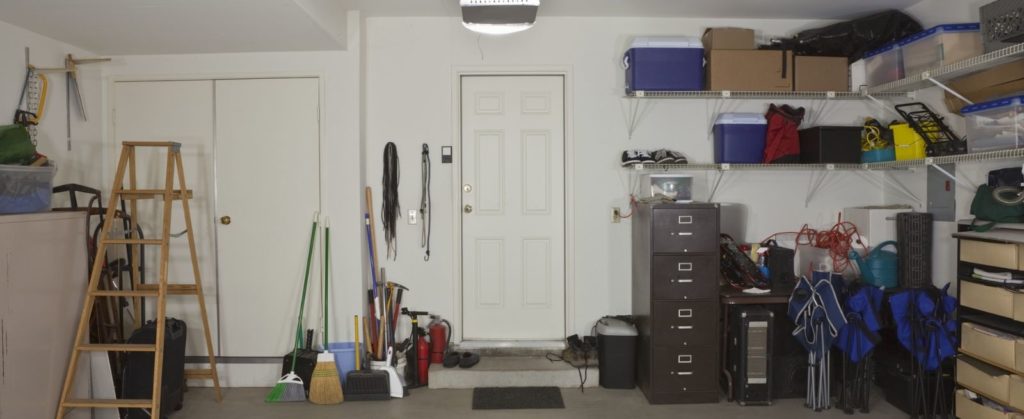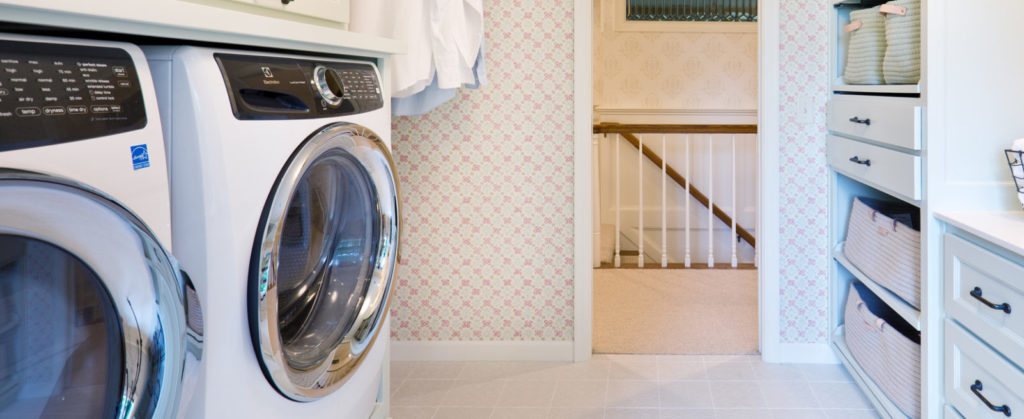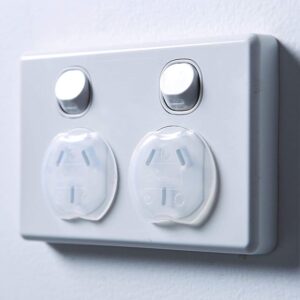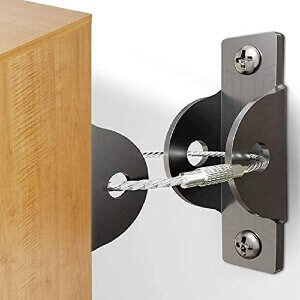To ensure your cot meets current child safety standards, always buy new. Old cribs may contain broken parts, toxic materials, or dangerous designs like drop sides.
The cot mattress should fit firmly along all four sides so there are no gaps for the baby to fall into.
We like the Grotime Jiminy Cot thanks to its adjustable base levels, making it usable from birth to around five years of age.
Bedding and stuffed animals
Those stuffed animals and handmade quilts are adorable, but for young babies, they’re a suffocation risk. Keep 'em out of the cot until your child is older and able to sit on their own.
If you’ve opted for a tidy box instead of open shelving, you’ll want to make sure your toy storage has hinge guards and soft-close hinges so it doesn’t close automatically, trapping your tyke inside or hurting their fingers.
Changing table with strap
We have all done it. You were just out of reach for a moment, grabbing that fresh nappy. But that was the exact instant your baby chose to demonstrate an ability to roll over.
Attach a changing pad with high sides and a safety strap—like the Childcare Universal Change Pad—to your changing table to prevent tumbles. But babies are wiggly and wily, so don't walk away from your little one even though they're strapped in.
Keep supplies at the table or move your changing pad to the floor once baby becomes more mobile as an extra precaution against falls.
A gorgeous mobile is the centerpiece of any nursery. It’s also dangling enticingly right above a baby who can now reach for it and pull it down. Move the mobile, or raise it higher to keep it from becoming a hazard.
Inspect blinds and window coverings for loose or dangling cords, which pose a strangulation or choking hazard. Use cord keepers or switch to cordless blinds.
Windows also present a fall risk for babies and toddlers. Add extra security to your windows with child-proof window locks.
Guard against sharp, head-height edges on your tables and lower pieces of furniture with bumpers and edge covers. Look for corner guards that are non-toxic and large enough not to become choking hazards if they get pried loose by curious fingers.
Bookcases can look like a staircase to little feet eager for a climbing challenge, so be sure they’re secured to the wall with anchors.
Smaller objects, glass figurines, and more probably crowd tabletops and shelves in your living spaces. Even if they’re not going to win you a bundle of money the next time Antiques Roadshow comes to town, you still want to place knickknacks out of reach. Once broken, smaller fragments could cut your young child or cause them to choke.
Use heavy-duty double-sided tape to prevent items from falling if their shelf is jostled by a hyper toddler.
Flickering lights and curious sounds emit from this enormous box, and most kids are eager to get up close and personal. Secure your TV with an anchoring system and NEVER, EVER place it on top of a dresser where it could tip and tumble onto your toddler.
This part of your home is hot stuff. Keep your little one from toddling into trouble by fencing it off after lighting a fire and protecting any hard edges around the hearth with edge guards.
Welcome to the digital age and the ever-expanding issue of cord management. They’re messy and unsightly but even worse for your child, they also pose a strangulation hazard. Get ‘em up and out of the way with ties, tape, or covers designed to keep your cords close and your child safe.
Perhaps the most important aspect of bathroom safety involves never, ever leaving your baby unattended in the tub, even for a second. It takes as little as 5 cm of water for drowning to occur.
Turn your furnace down to prevent scalds from hot water and get a thermometer for the tub. Around 37 - 38°C is a comfy temp for your baby's bath water.
Wet babies are slippery babies, so install a nonslip mat to help you get a grip.
Beauty and personal care products
Many of the chemicals in hygiene products are as caustic as those in cleaning supplies if ingested, so clear the bathroom counter of cosmetics and use cabinet locks to keep bathroom drawers shut. Hair straighteners and other heated appliances should be unplugged and tucked away when not in use.
Poison control hotline
Don’t have the number for the Australian poison hotline in your phone? Add it now:
Poisons Information Centre: 131 126
Get a toilet lock. Seriously. Your kid might mistake that inviting bowl of water as a place to play. Ewww!
Kids can also drown in toilet water. Lock it down.
Maybe there are some cupboards you’re willing to let baby explore. After all, banging pots and pans is a sacred rite of childhood. Inspect yours and decide what needs to be moved or locked up. You should definitely consider securing the following items.
• Cleaning products
• Liquor and tobacco products
• Sharp objects
• Anything made out of glass
• Plastic or paper bags
Do you have a few of these on your fridge? Of course you do! Everybody does. But you’ll want to move them. Most magnets are small and easy to swallow, and the stronger ones can wreak havoc if ingested.
Shiny knobs are great fun to turn, and while it’s good motor practice, it is also a terrible risk for your tyke. Knob covers, stove guards, and oven locks are all helpful in keeping little fingers away from the heat.
We mentioned this one before, but it’s a risk worth harping on. Kids are used to eating vitamins. They’re cute and colourful, and they come in familiar shapes that look exactly like candy.
In small doses, they bolster health. In large doses, they can cause iron poisoning. Make sure you’re the only person who can hand out the health supplements by keeping them out of reach and locked up.
Accidents happen, even to parents. Especially in the kitchen. There’s a gross bathroom emergency or a screech as someone tumbles down the stairs, and the last thing you’re thinking about is that pot you left on the stove.
Keep a fire extinguisher accessible, but be careful that it’s not within reach of your child. They're heavy and could really hurt a kid if pulled off a counter, not to mention the fact that the fire retardant in extinguishers is toxic to ingest even in small doses.
Even if they’re out of reach, far back on the counter, you’ll have an adventurous climber sooner than you anticipated. Keep appliances like toasters, mixers, and coffeepots unplugged when not in use.
You’re probably not ready for the slamming doors that come with raising teenagers, and neither are your little one’s fingers. Use doorknob locks, hinge guards, doorstops, pinch guards, and other simple gadgets to prevent passage and protect your toddler.
If there's no physical door to secure, set up a baby gate to limit your toddler's access.
Restrict access to these steep challenges with a safety gate. We like this retractable baby gate by Dreambaby because it fits spaces up to 140cm wide, can be opened with one hand, and doesn't feature a floor bar for everyone to trip over.
Unless you want to go slip-sliding away, you should make an effort to secure floor rugs and loose carpeting. Grippers and nonstick pads are available to protect your floors and keep your feet from flying out from under you.
Keep your vehicle doors locked so when your little one decides to become the next Supercars driver, they won’t be able to put the pedal to the metal.
Keep receptacles that could gather water turned over so they don’t become small water features that’ll attract your child and pose a drowning risk.
Hazardous and flammable materials
This involves more than just putting all those unused cans of paint away. Secure cleaning products and other chemicals and lock down tools, especially those with sharp edges.
Use childproof cabinet locks and add door sensors for an extra layer of security.
Many people keep cleaning supplies in the basement or laundry room. Make sure they’re in an out-of-reach cabinet or behind a securely locked cupboard. And keep poison control on speed dial regardless.
Poisons Information Centre Australia: 131 126
Washing machine and dryer
Anchor these heavy appliances and ensure they're locked so little hide-and-seekers don’t dive in.
The little holes that accommodate your electrical appliances are unfortunately perfect for tiny digits. Remove temptation with outlet covers but beware of the cheap plastic inserts, which can become choking hazards. We like Dreambaby's outlet covers because of how difficult they are to remove, making them much harder for your child to get one loose and for it to become a choking hazard.
A crawling baby constantly uses furniture to get a leg up, but it’s a dangerous endeavor. If you have a heavy piece of furniture or electronic device that isn’t secure, it could topple over and crush your child.
Furniture tip-overs cause have caused at least 27 deaths in Australia since 2000, with thousands more injured each year—but it’s easily preventable with furniture anchors. Use two anchors, and make sure they’re screwed into the wall studs so your little sweetie can continue trying to scale every surface safely.
Use the Sydney Children's Hospitals Network's illustrated guide to poisonous plants to identify your houseplants. Get rid of any that are poisonous.
Other plants have trailing vines that can be of concern. Keep plants up high and away from prying fingers.
Fido’s food is probably not the best source of nutrition for your baby, and it’s definitely a serious risk for choking. Closely supervise mealtime, and when your pet is done, put their food up.
All kinds of batteries are dangerous and can cause internal burns if ingested. The small button batteries that are in many small electronics and toys also represent a choking hazard. Check to be sure all the things that talk and tick have batteries secured behind screw-on covers.

